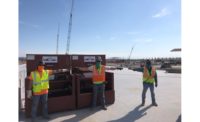Anyone who has ever been on a construction site knows that surprises, complications and unforeseen circumstances are a nearly unavoidable reality, with even the most skilled and experienced engineering and construction professionals susceptible to them.
The question is how do you, the contractor, handle them? For some project managers for contractors, on-site hiccups — and the cost and time overruns they bring about — are just a cost of doing business. You deal with them and move on.
But what if you could reduce them?
What would that be worth in terms of faster turnarounds? Safer, more efficient job sites, increased profits and happier clients?
That’s the question being asked by a growing group of engineers and contractors who are starting to embrace a new class of digital twin technologies
Digital Twins For Construction
This isn’t a digital twin as you may think of it, that's a one model handover to the owner. This is a 3D digital twin that changes with your site.
A digital twin is a digital representation of something in the physical world. BIM/VDC technologies have been around for a while and are well known for their use in preconstruction planning, but 3D digital twin technology delivers a view of how the construction site looks like now — not just how it was designed to look. Thanks to reality capture technology, what’s going on with a construction site can constantly be updated in the 3D model to reflect the as-built environment. Those two factors, a) being in 3D, and b) depicting a current representation of the physical reality of a job site, are game changers for professionals in the engineering and construction sectors — and for owners, too.
There’s an even bigger change at play, and that’s where and when digital twin technology is used in a building’s life cycle. When you think of BIM/VDC, you probably think of it as being used in the planning stages. But 3D digital twin technologies are being used throughout the entire life cycle of properties — from pre-construction all the way through to maintenance and operation. Having up-to-date 3D visual representations of a physical site or asset while enabling secure collaboration and ongoing data analytics across the enterprise delivers all kinds of value to everyone involved in the project: owners, engineers, general contractors and subcontractors, project managers, BIM/VDC experts, and property management companies.
The Collaboration Piece
COVID-19 changed a lot in all of our daily lives. Traveling got more difficult and some aspects of those changes, especially as related to remote working, seem likely to stick around. With 3D visual digital twin technology, anybody who needs access to the 3D model can have in-depth, accurate, up-to-date and secure access to the as-built specifics of any project. That’s probably why more and more owners are beginning to require their general contractors and construction teams to use 3D digital twins.
3D digital twin technology makes it easier to manage the multiple complexities inherent in projects. If your goal is to stay on time, on budget and on target, 3D digital twin technology increases your odds significantly.
Simon Bae is the found and CEOof Cupix, a 3D digital twin software and hardware maker.





Post a comment to this article
Report Abusive Comment